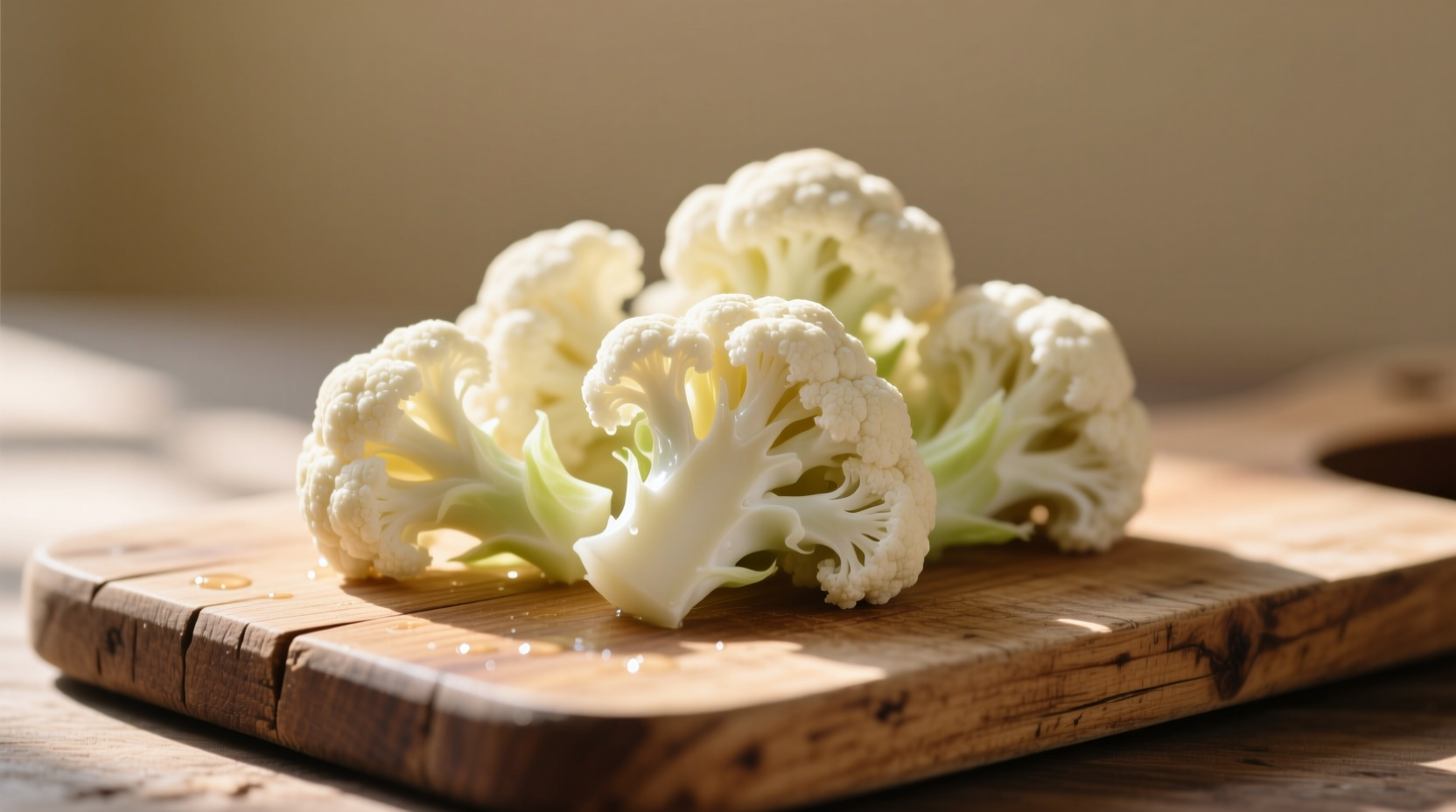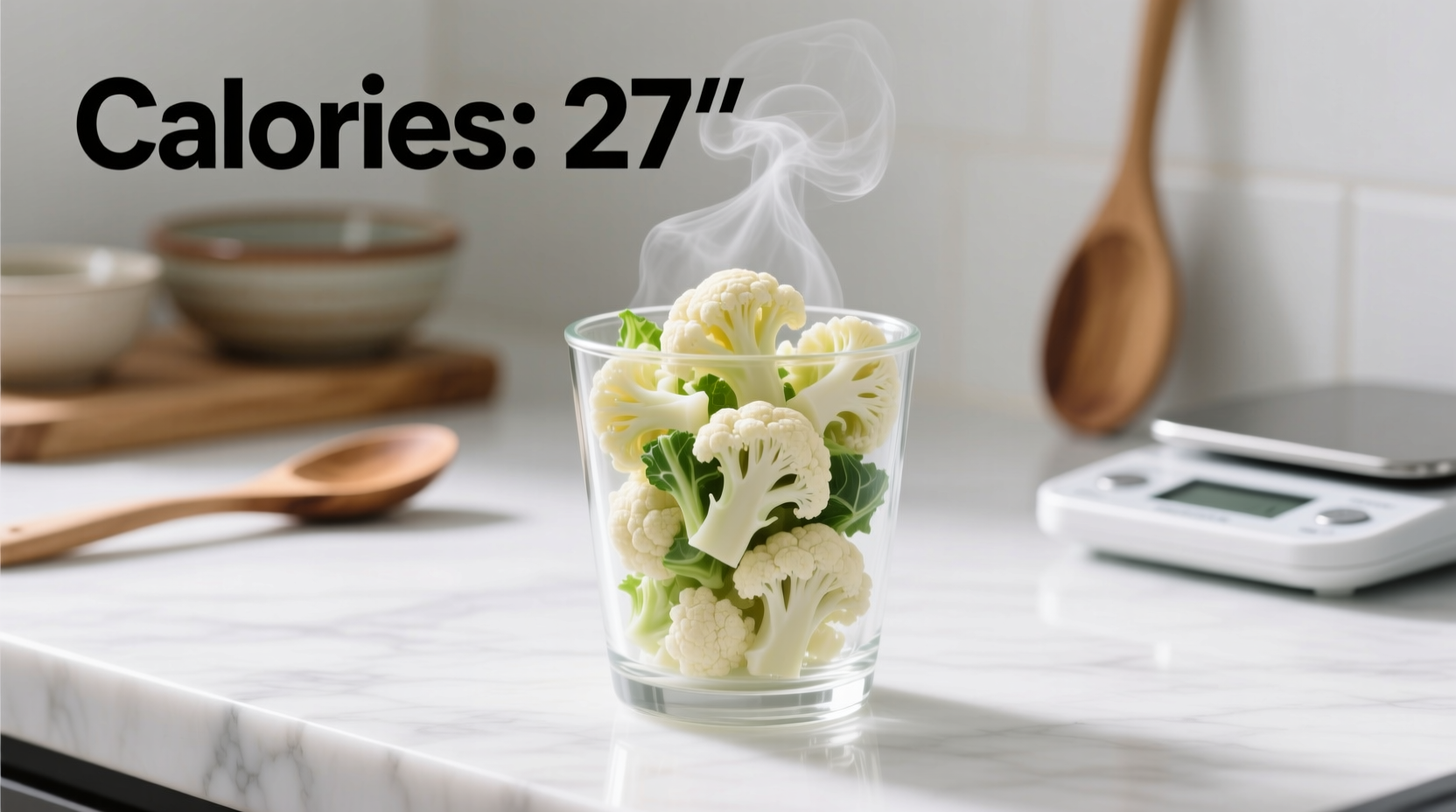Understanding exactly how many calories are in cauliflower helps you make informed dietary choices without sacrificing nutrition. Whether you're tracking macros, managing weight, or simply eating healthier, cauliflower's impressive nutritional profile delivers substantial benefits with minimal caloric impact.
Complete Nutritional Breakdown of 1 Cup Cauliflower
According to the USDA FoodData Central database, a standard 1-cup serving (100g) of raw cauliflower provides these essential nutrients:
| Nutrient | Amount | % Daily Value |
|---|---|---|
| Calories | 25 | 1% |
| Total Fat | 0.3g | 0% |
| Carbohydrates | 5g | 2% |
| Dietary Fiber | 2g | 7% |
| Protein | 2g | 4% |
| Vitamin C | 48.2mg | 77% |
| Vitamin K | 15.5mcg | 13% |
| Folate | 57mcg | 14% |
This nutritional powerhouse contains virtually no fat while delivering substantial fiber and critical vitamins. The high water content (92%) contributes to its low-calorie density, allowing you to eat generous portions without exceeding calorie goals.
Calorie Variations by Preparation Method
The calorie count changes slightly depending on how you prepare cauliflower. Here's how different cooking methods affect the nutritional profile:
- Raw cauliflower (1 cup): 25 calories - retains maximum vitamin C content
- Steamed cauliflower (1 cup): 28 calories - minimal nutrient loss
- Roasted cauliflower (1 cup with 1 tsp olive oil): 68 calories - enhanced flavor but higher calories
- Riced cauliflower (1 cup): 25 calories - identical to raw, popular low-carb alternative
- Cauliflower mash (1 cup with 1 tbsp milk): 45 calories - creamy texture with moderate calorie increase
For those tracking calories precisely, remember that cooking methods involving added fats significantly increase the calorie count, while water-based cooking preserves the vegetable's naturally low-calorie profile.

Why Cauliflower's Calorie-to-Nutrient Ratio Matters
Cauliflower exemplifies nutrient density - delivering maximum vitamins and minerals per calorie consumed. This characteristic makes it particularly valuable for:
- Weight management: You can eat substantial portions while staying within calorie limits
- Dietary flexibility: Easily fits into keto, paleo, vegan, and Mediterranean eating patterns
- Nutrient optimization: Provides 77% of your daily vitamin C needs in just 25 calories
Research from the Harvard T.H. Chan School of Public Health confirms that non-starchy vegetables like cauliflower should form the foundation of healthy eating patterns due to their exceptional nutrient-to-calorie ratio. Their analysis of dietary patterns shows populations consuming higher amounts of cruciferous vegetables experience better long-term health outcomes.
Practical Ways to Incorporate Low-Calorie Cauliflower
Maximize cauliflower's nutritional benefits with these practical strategies:
- Substitute for higher-calorie ingredients: Replace half the potatoes in mashed potatoes with cauliflower for 30% fewer calories
- Create satisfying bases: Use riced cauliflower instead of grains for bowls and stir-fries
- Boost vegetable intake: Add finely chopped cauliflower to sauces, soups, and casseroles without altering flavor
- Make guilt-free snacks: Roast cauliflower florets with minimal oil for a crunchy, high-fiber snack
- Enhance smoothies: Add raw cauliflower to fruit smoothies for creaminess without significant calorie impact
How Cauliflower Compares to Other Vegetables
Understanding where cauliflower stands among similar vegetables helps you make informed choices. This comparison shows calories per 1-cup serving:
| Vegetable | Calories (1 cup) | Fiber (g) | Protein (g) |
|---|---|---|---|
| Cauliflower | 25 | 2 | 2 |
| Broccoli | 34 | 2.4 | 2.6 |
| Spinach (raw) | 7 | 0.7 | 0.9 |
| Zucchini | 20 | 1.2 | 1.5 |
| Carrots | 52 | 3.6 | 1.2 |
While spinach has fewer calories, cauliflower provides significantly more protein and comparable fiber. Compared to carrots, cauliflower offers similar texture applications with less than half the calories. This versatility makes cauliflower uniquely valuable for various dietary approaches.
Maximizing Nutrient Retention When Cooking
Preserve cauliflower's nutritional value with these evidence-based preparation tips from the Journal of Food Science:
- Steam instead of boil: Water-soluble vitamins like vitamin C leach into cooking water during boiling
- Keep cooking time short: 5-7 minutes preserves maximum nutrients while improving digestibility
- Store properly: Keep whole heads refrigerated in perforated bags for up to 2 weeks
- Don't discard stems: They contain similar nutrients to florets and can be used in stocks or finely chopped
Recent research published in the Journal of Agricultural and Food Chemistry confirms that steaming preserves 90% of cauliflower's vitamin C content compared to only 60% retention with boiling. This simple preparation adjustment significantly enhances the nutritional payoff from your cauliflower consumption.
Addressing Common Misconceptions
Several myths persist about cauliflower's nutritional value:
- Myth: All preparation methods yield identical nutritional benefits
Fact: Cooking method significantly impacts nutrient retention, particularly for vitamin C - Myth: Frozen cauliflower has fewer nutrients than fresh
Fact: Flash-frozen cauliflower often retains more nutrients than fresh produce that's been transported long distances - Myth: Cauliflower lacks protein
Fact: At 2g per cup, it provides more protein per calorie than many other vegetables
Understanding these distinctions helps you maximize cauliflower's nutritional potential in your diet.
Practical Meal Planning Applications
Incorporate cauliflower strategically throughout your day:
- Breakfast: Add riced cauliflower to morning scrambles (adds volume with minimal calories)
- Lunch: Create cauliflower-based salads that stay satisfying without excessive calories
- Dinner: Substitute cauliflower for higher-carb ingredients in traditional recipes
- Snacks: Enjoy raw florets with hummus for a balanced, nutrient-dense snack
Dietitians at the Mayo Clinic recommend including cruciferous vegetables like cauliflower in at least three meals per week to maximize health benefits while maintaining healthy weight management.











 浙公网安备
33010002000092号
浙公网安备
33010002000092号 浙B2-20120091-4
浙B2-20120091-4